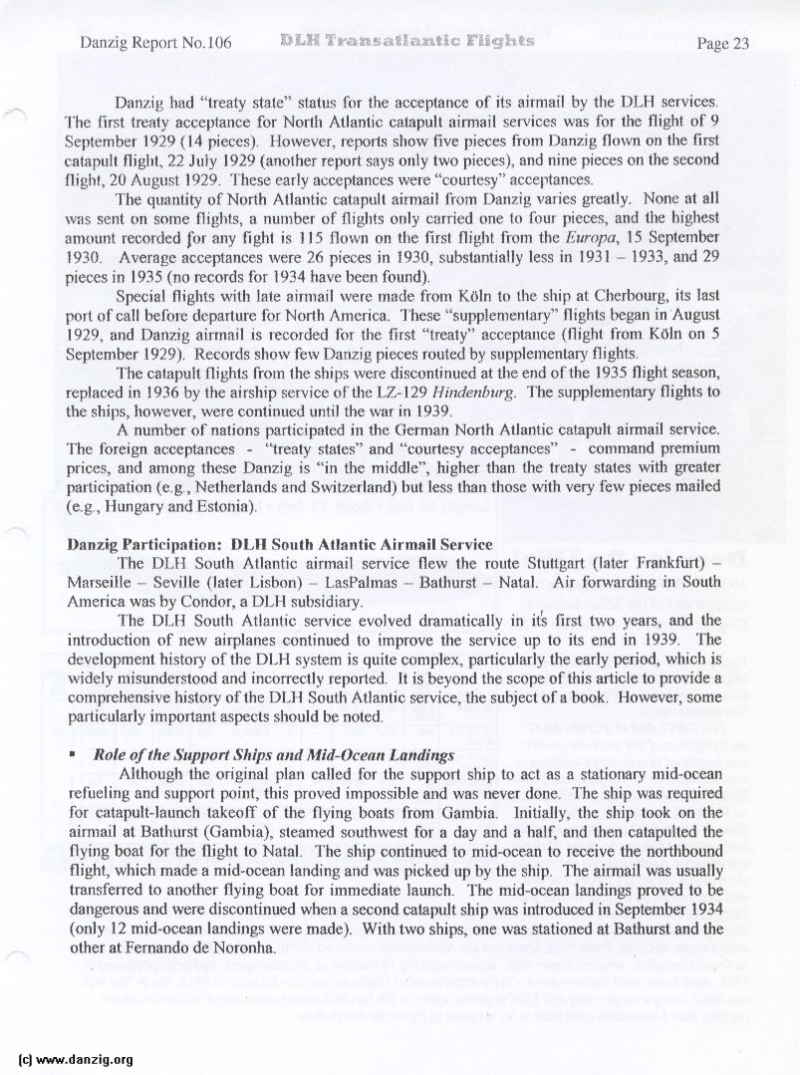
Danzig had “treaty state” status for the acceptance of its airmail by the DLH services. The first treaty acceptance for North Atlantic catapult airmail serviccs was for the flight of 9 September 1929 (14 pieces). However, reports show five pieces from Danzig I lown on the first catapult flight. 22 July 1929 (another report says only two pieces), and nine pieces on the second flight, 20 August 1929, ‘these early acceptances were “courtesy” acceptances.
The quantity of North Atlantic catapult airmail from t)aiizig varies greatly. None at all was sent on some flights, a number of flights only carried one to four pieces, and the highest amount recorded for any fight is 11 5 flown on the first flight ti’oin the Euro,a, 15 September 1930. Average acceptances were 26 pieces in 1930, substantially less in 1931 1933, and 29 pieces in 1935 (no records for 1934 have been found).
Special flights with late airmail were made from KOIn to the ship at Cherbourg, its last port of call before departure for North America. These “supplementary” flights began in August 1929, and L)anzig airmail is recorded for the first “treaty” acceptance (flight from KOIn on 5 September 1929). Records show few Danzig pieces routed by supplementary flights.
The catapult flights from the ships were discontinued at the end of the 1935 flight season, replaced in 1936 by the airship service of the [2-129 Jlindenburg. The supplementary flights to the ships, however, were continued until the war in 1939.
A number of nations participated in the German North Atlantic catapult airmail service. The loreign acceptances - “treaty states” and “courtesy acceptances” - command premium prices, and among these Danzig is “in the middle”, higher than the treaty stales with greater participation (e.g., Netherlands and Switzerland) but less than those with very few pieces mailed (e.g., hungary and Estorna).
Danzig Participation: DLHSmith Atlantic Airmail Service The DLH South Atlantic airmail service flew the route Stuttgart (later Frankfurt) Marseille — Seville (later Lisbon) — LasPalmas — I3athurst — Natal. Air forwarding in South America was by Condor, a DLH subsidiary.
The DLH South Atlantic service evolved dramatically in it first two years, and the introduction of new airplanes continued to improve the service up to its end in 1939. [lie development history of the DLH system is quite complex, particularly the early penod, which is widely misunderstood and incorrectly reported. It is beyond the scope of this article to provide a comprehensive history of the Dlii South Atlantic service, the subject of a book, However, some particularly important aspects should be noted,
Role of the Support Ships and Mid-Ocean Landings
Although the original plan called for the support ship to act as a stationary mid-ocean refueling and support point, this proved impossible and was never done. The ship was required for catapult-launch takeofi of the flying boats from Gambia. Initially, the ship took on the airmail at Batlmurst (Gambia), steamed southwest fo, a day and a half, and then catapulted the flying boat for the Ihight to Natal, The ship continued to mid-ocean to receive the northbound flight, which made a mid-ocean landing and was picked up by the ship. The airmail was usually transferred to another flying boat for immediate launch. The mid-ocean landings proved to be dangerous and were discontinued when a second catapult ship was introduced in September 1934 (only 12 mid-ocean landings were made). With two ships, one was stationed at I3athurst and the other at Fernando de Noronha.
Danzig Report Vol. 1 - Nr. 106 - January - February - March - 2000, Page 23.
Hits: 3582
Added: 27/07/2015
Copyright: 2025 Danzig.org

